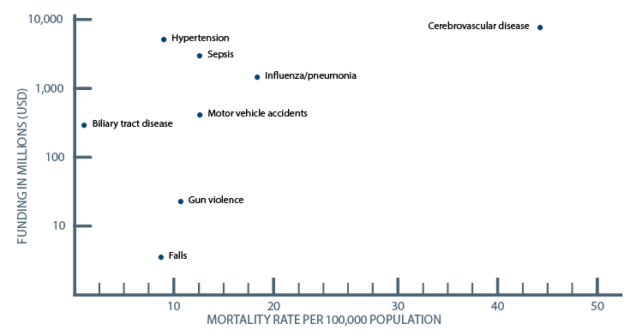
Explore This Issue
ACEP Now: Vol 40 – No 11 – November 2021Last month we debunked five myths about trauma and triage in older patients—the fastest growing population in the United States.1 This month we’ll look at falls and other common injuries.
Older adults with severe injuries represent at least 40 percent of all adults with severe injuries.2 Ground-level falls are the most common mechanism of injury in older patients and carry a 10-fold higher mortality rate.3 Research funding to study falls, relative to their associated mortality, is much lower than comparable conditions—including firearm deaths (see Figure 1).4 Older trauma patients with falls are often undertriaged at the ED triage as well as to regional trauma centers.5-8
Myth 6: Unstable C-Spine Injuries Are Unlikely After Ground-Level Fall
Older patients are more likely to sustain fractures (especially vertebral fractures) at much lower forces due to osteoporosis and reduced bone mass. Half of cervical spine injuries in older patients are considered unstable and older patients are at higher risk for central and anterior cord syndromes.9 Any older trauma patient who is undergoing a head CT to rule out traumatic brain injury should also be considered for cervical spine imaging.
Myth 7: Anticoagulant Medications Should Always Be Withheld After Minor Head Injury in Older Patients
While anticoagulants should certainly be withheld after major head injury with evidence of traumatic intracranial hemorrhage, cessation of anticoagulation is unnecessary following an ED visit for minor head injury without evidence of intracranial hemorrhage.10 In the context of warfarin for primary stroke prevention in atrial fibrillation, observational data suggest that a person would need to fall 295 times in one year for the risk of a subdural hemorrhage to outweigh the benefits of warfarin therapy.11 This risk-benefit ratio would predictably be even more favourable for direct oral anticoagulants since they have been shown to carry a lower risk of intracranial hemorrhage than warfarin.12
Myth 8: Isolated Rib Fractures Are Benign Injuries That Do Not Require Treatment
Frailty is one of the strongest predictors of mortality following rib fractures, and mortality increases proportionally with each additional rib fracture.13 Rib fractures are a surrogate marker for polytrauma—observational data suggest that 81 percent of patients with rib fractures have additional associated traumatic injuries.14 CT is the imaging modality of choice, as chest X-ray has been shown to miss up to 50 percent of rib fractures. There is a higher incidence of pulmonary contusions, pneumonia, and respiratory failure requiring mechanical ventilation in older patients with rib fractures. It is prudent to have a low threshold to order a CT of the abdomen to rule out solid organ injury that also has a higher incidence in older patients who have sustained rib fractures.15 Consider transfer to a regional trauma center for older patients with three or more rib fractures, bilateral rib fractures, flail segment, or any rib fracture in an older patient with significant underlying pulmonary disease.16
Myth 9: Hip Fractures Do Not Require Urgent Surgery
Observational studies suggest that delays to surgery for hip fractures are associated with higher 30-day mortality, pulmonary embolism, myocardial infarction, and pneumonia.17 The recent HIP Fracture Accelerated Surgical TreaTment And Care tracK (HIP ATTACK) randomized controlled trial compared time to surgery of less than six hours versus usual care and found a lower rate of delirium, stroke, infection, and urinary tract infection.18 It is incumbent upon the emergency physician to help facilitate timely transfer to the operating room for all patients requiring surgery for hip fractures.
Myth 10: Older Patients Who Are Discharged from the ED with a Non-injurious Fall Do Not Require Specific Follow-up Assessments
Persons with single non-injurious falls who have normal gait and balance are considered at low risk for recurrent falls. Older patients who present to the emergency department after a fall should have a quick gait and balance assessment completed in the emergency department. Time-efficient validated assessment tools include the timed up and go test and the modified 30 second sit to stand test.19,20 Patients at high risk for recurrent falls include those with a fall resulting in injury, a gait or balance disorder, two or more falls in the past 12 months or a Clinical Frailty Scale of 4–9.21 All such patients should be considered for evidence-based fall-reduction management, including referral for an occupational therapy home safety assessment, falls prevention program, and communication with the primary care physician to conduct a full fall risk assessment and screen for conditions predisposing to injurious falls, such as osteoporosis.22
A special thanks to Dr. Barbara Haas, Dr. Bourke Tillman, and Dr. Camilla Wong for their expert contributions to the EM Cases podcast from which this article was inspired.
Pages: 1 2 3 | Single Page






No Responses to “Geriatric Trauma Myths and Misperceptions: Part 2”